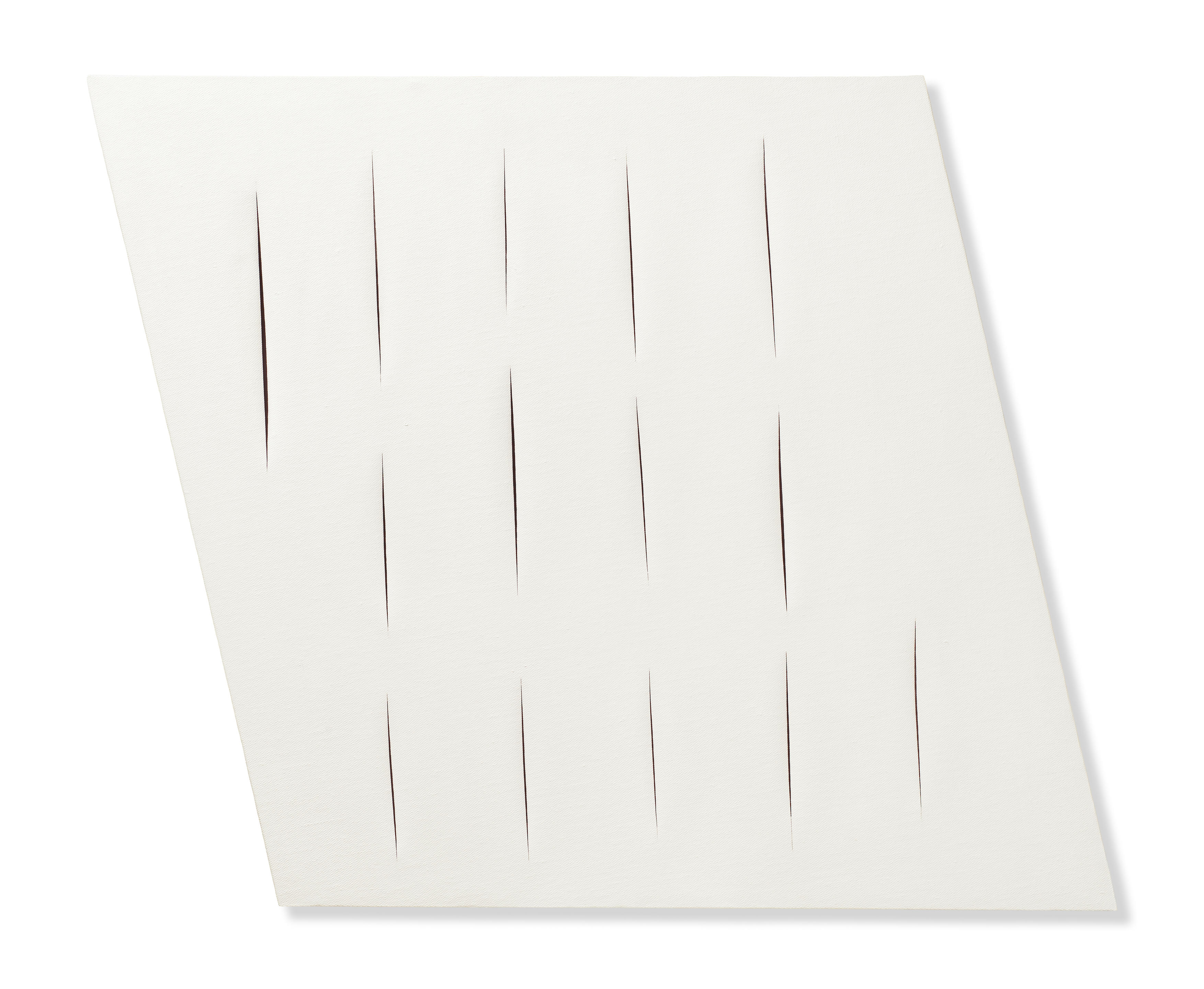Lucio Fontana Concetto spaziale (Teatrino) 1966 Aquarelle on canvas, black, and lacquered wood. 49 1/4 x 51 1/8in. (125 x 130 cm). Signed and titled “Fontana/ ‘Concetto Spaziale’” on the reverse.
Provenance Malborough Galleria d’Arte, Rome; Galerie des Art Anciens et Modernes, Schaan; Galleria Cesarea, Genoa; Galleria La Bertesca, Genoa; Massimo Minini, Brescia Exhibited The Hague, 1967; Brussels, Bernard Cats, October 9 – November 21, 1987 Literature E. Crispolti, Lucio Fontana Catalogue Raisonné, Vol. II, Brussels, 1974, no. 66 TE 9, p. 176-177 (illustrated); E. Crispolti, Lucio Fontana Catalogue Raisonné, Vol. II, Brussels, 1986, p. 619 (illustrated); C. M. Dell and K. GallWitz, eds., Axa Art - Corporate Collecting Today, Cologne, 2001, p. 191 (illustrated); E. Crispolti, Lucio Fontana catalogo ragionato di sculture, dipinti, ambientazioni,Vol. II, Milan, 2006, p. 808, (illustrated) Catalogue Essay In Fontana's marvelous Concetto spaziale, we discover the lost epic of contemporary Modernism....There is a sensuality about this work that is inexplicable, a heartening desire to open up the threshold of space, to ascend to new levels of cosmic reality within the mind, to offer a sense of the physical in relation to the intellect, in relation to the spiritual. Fontana's cuts and holes are as famous as Pollock's pours and drips, yet their intentions are widely different. Once emphasized the physical in terms of the mental, the other the mental in terms of the physical. The consistency of Fontana's work is particularly alluring. The depth of feeling, the penetration of pictorial space is what becomes an astounding feature of the work. Each painting has an undeniably intuitive sense of resolution, a feeling of wholeness through negation. They are crafted and elegant. They are deftly understood as conceptual in intention, while, at the same time, fully entrenched in the traditions from which they attempt to dispel themselves. Fontana is an anomaly of late Modernism. His work is a mystery that defies previously identified categories. His paintings have the signature of a child's mark, the cultural signifier of a heretic of art who, at the same time, refused to give up his polemical stance. Fontana knew what he wanted and he would not let go of the repetition of his desire. His focus was on the future of and through this focus, he relieved himself of self-importance and gained the quintessential humility that allows great art to happen. He could withstand the assault of titillating excess. R. C. Morgan, Lucio Fontana Review, 15 March, 2000, pp. 18-19 Read More
Lucio Fontana Concetto spaziale (Teatrino) 1966 Aquarelle on canvas, black, and lacquered wood. 49 1/4 x 51 1/8in. (125 x 130 cm). Signed and titled “Fontana/ ‘Concetto Spaziale’” on the reverse.
Provenance Malborough Galleria d’Arte, Rome; Galerie des Art Anciens et Modernes, Schaan; Galleria Cesarea, Genoa; Galleria La Bertesca, Genoa; Massimo Minini, Brescia Exhibited The Hague, 1967; Brussels, Bernard Cats, October 9 – November 21, 1987 Literature E. Crispolti, Lucio Fontana Catalogue Raisonné, Vol. II, Brussels, 1974, no. 66 TE 9, p. 176-177 (illustrated); E. Crispolti, Lucio Fontana Catalogue Raisonné, Vol. II, Brussels, 1986, p. 619 (illustrated); C. M. Dell and K. GallWitz, eds., Axa Art - Corporate Collecting Today, Cologne, 2001, p. 191 (illustrated); E. Crispolti, Lucio Fontana catalogo ragionato di sculture, dipinti, ambientazioni,Vol. II, Milan, 2006, p. 808, (illustrated) Catalogue Essay In Fontana's marvelous Concetto spaziale, we discover the lost epic of contemporary Modernism....There is a sensuality about this work that is inexplicable, a heartening desire to open up the threshold of space, to ascend to new levels of cosmic reality within the mind, to offer a sense of the physical in relation to the intellect, in relation to the spiritual. Fontana's cuts and holes are as famous as Pollock's pours and drips, yet their intentions are widely different. Once emphasized the physical in terms of the mental, the other the mental in terms of the physical. The consistency of Fontana's work is particularly alluring. The depth of feeling, the penetration of pictorial space is what becomes an astounding feature of the work. Each painting has an undeniably intuitive sense of resolution, a feeling of wholeness through negation. They are crafted and elegant. They are deftly understood as conceptual in intention, while, at the same time, fully entrenched in the traditions from which they attempt to dispel themselves. Fontana is an anomaly of late Modernism. His work is a mystery that defies previously identified categories. His paintings have the signature of a child's mark, the cultural signifier of a heretic of art who, at the same time, refused to give up his polemical stance. Fontana knew what he wanted and he would not let go of the repetition of his desire. His focus was on the future of and through this focus, he relieved himself of self-importance and gained the quintessential humility that allows great art to happen. He could withstand the assault of titillating excess. R. C. Morgan, Lucio Fontana Review, 15 March, 2000, pp. 18-19 Read More











.jpg)


Try LotSearch and its premium features for 7 days - without any costs!
Be notified automatically about new items in upcoming auctions.
Create an alert